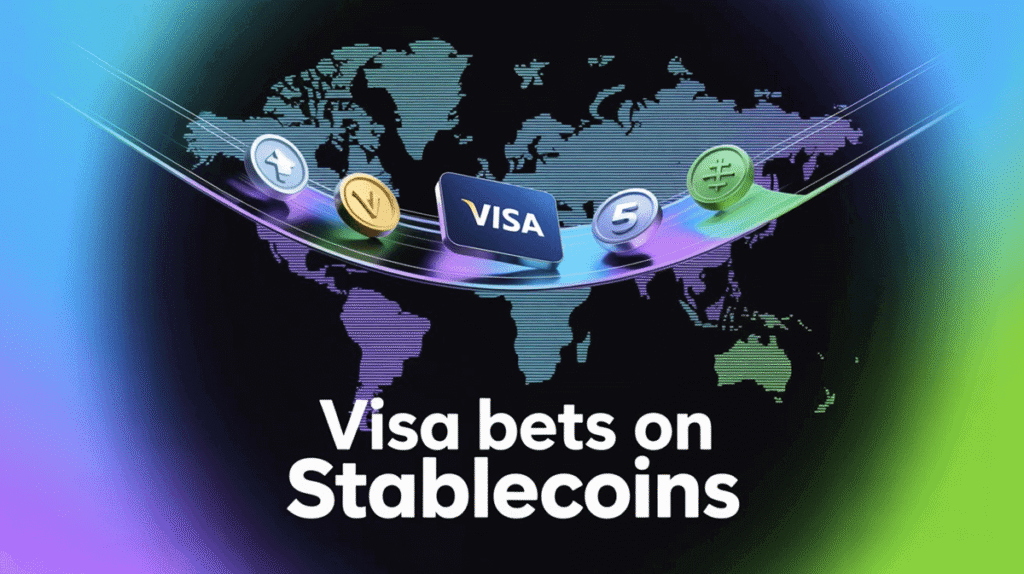Visa Launches Stablecoin Pilot to Revolutionize Cross-Border Payments
Key Takeaway: Visa’s stablecoin pilot marks a turning point in cross-border payments. Using USDC and EURC via Visa Direct, it delivers near-instant settlements, capital efficiency, and reduced risk. Backed by regulatory clarity, Visa aims to transform a $195T market, intensifying competition and accelerating institutional adoption of blockchain-based money movement. Payment giant’s new system promises instant global money transfers, challenging traditional banking infrastructure
Visa Inc. has unveiled a groundbreaking pilot program that enables financial institutions to use stablecoins for instant cross-border payments, marking a significant shift in how global money movement operates. The initiative, announced at SIBOS 2025, allows businesses to prefund payments using digital currencies through Visa’s Direct platform.

Transforming Traditional Payment Systems
The pilot program utilizes Circle Internet Group’s USD Coin (USDC) and euro-backed EURC stablecoins to facilitate near-instant settlements across borders. Under this revolutionary system, businesses can send stablecoins to Visa, which treats them as prefunded balances to back payouts in local currencies worldwide.
“Cross-border payments have been stuck in outdated systems for far too long,” said Chris Newkirk, President of Commercial & Money Movement Solutions at Visa. “Visa Direct’s new stablecoins integration lays the groundwork for money to move instantly across the world, giving businesses more choice in how they pay.”
Traditional cross-border payment systems often require days to complete transactions and force businesses to tie up substantial capital in advance. The new stablecoin solution addresses these inefficiencies by enabling real-time money movement while optimizing capital deployment.
How the System Works
The technology tackles a critical challenge faced by remittance companies and financial institutions that must maintain prefunded accounts across multiple markets to handle customer withdrawal requests. When these accounts become underfunded during non-business hours or weekends, consumers can face multi-day payment delays.
Mark Nelsen, Visa’s head of product for commercial and money movement solutions, explained the system’s advantages: “We’re giving this immediate ability to get money to the accounts in real time. It’s a more efficient use of capital so you can deploy it as needed as opposed to having to deploy two or three days’ worth of money in one spot”.
The stablecoin prefunding mechanism offers three key benefits:
Capital Efficiency: Institutions can unlock working capital that would otherwise remain parked in advance, keeping funds actively deployed while ensuring payout coverage.
Operational Speed: Money movement accelerates from days to minutes, enabling dynamic liquidity management and responsive treasury operations.
Risk Mitigation: Stablecoins provide consistent settlement layers, reducing exposure to local currency volatility while stabilizing treasury functions.
Market Impact and Early Results
Visa has already processed over $225 million in cumulative stablecoin volume through this pilot program, though this represents just a fraction of the company’s $16 trillion in annual payment transactions. The program currently operates with select partners meeting Visa’s pilot criteria, with broader availability planned for April 2026.
Recipients continue receiving payments in their local currencies, ensuring seamless end-user experiences while the underlying infrastructure modernizes. This approach maintains familiar payment processes while leveraging blockchain technology’s efficiency gains.
Regulatory Clarity Drives Adoption
The timing aligns strategically with recent U.S. regulatory developments. The passage of the GENIUS Act in July 2025 established comprehensive stablecoin regulations, requiring 100% reserve backing with liquid assets and monthly public reserve disclosures.
“The Act changed everything so much more legitimate. Before that regulatory clarity, all the big institutions were sort of on the fence,” Nelsen emphasized.
This regulatory framework has accelerated institutional adoption across the broader stablecoin ecosystem. The global stablecoin market processed $32 trillion in transactions during 2024, with current market capitalization exceeding $250 billion. Industry projections suggest potential growth to $2 trillion within three years.
Competitive Landscape Intensifies
The announcement intensifies competition among traditional payment networks racing to capture stablecoin market opportunities. Cross-border payments using stablecoins currently represent approximately 3% of the estimated $195 trillion global cross-border payments market, but could grow to 20% within five years—creating a $60 trillion opportunity.
Recent developments demonstrate accelerating institutional adoption. Deutsche Börse Group and Circle signed a memorandum of understanding in September 2025 to collaborate on EURC and USDC usage within European financial infrastructure. Meanwhile, Mastercard expanded its Circle partnership to enable stablecoin settlement across Eastern Europe, Middle East, and Africa.
Building on Digital Asset History
This initiative builds upon Visa’s multi-year blockchain exploration. The company first enabled USDC settlement in 2021 for crypto-native clients, becoming among the first major payment networks to settle transactions in stablecoins. Visa has since facilitated nearly $100 billion in cryptocurrency purchases and over $25 billion in cryptocurrency spending through stablecoin-linked cards.
The company’s systematic approach reflects its collaboration philosophy rather than competition with digital assets. “The amount of software and technology that’s been deployed globally for payments is hard to recreate. So it seems more likely to just incorporate stablecoin technology into existing flows,” Nelsen noted.
Future Implications
The pilot’s success could catalyze broader financial services adoption, particularly as regulatory frameworks mature globally. With traditional banks twice as likely to prioritize cross-border payments over other stablecoin applications, Visa’s infrastructure development may provide crucial competitive advantages.
As the program expands in 2026, it will provide valuable insights into institutional stablecoin adoption patterns and operational challenges at scale, potentially reshaping global commerce through 24/7 settlement capabilities and reduced international transaction friction.
Sources: Based on Visa press releases, Reuters, Bloomberg, and financial news coverage of the SIBOS 2025 announcement.
